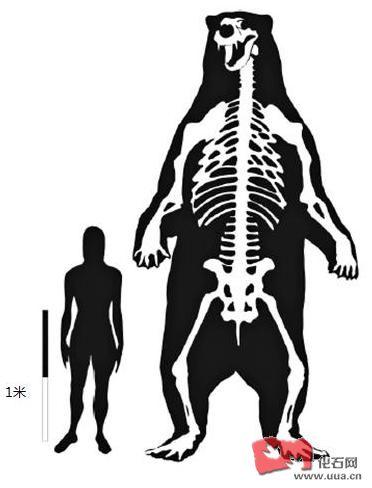

阿根廷大草原早更新世已知最大的熊类——a. 南美短面熊 Arctotherium angustidens:并讨论熊类的体型及饮食趋势
The Largest Known Bear, Arctotherium angustidens, from the Early Pleistocene Pampean Region of Argentina: With a Discussion of Size and Diet Trends in Bears
Leopoldo H. Soibelzon and Blaine W. Schubert
Abstract
The South American giant short-faced bear (Arctotherium angustidens Gervais and Ameghino, 1880) is one of five described Arctotherium species endemic to South America and it is known for being the earliest, largest, and most carnivorous member of the genus. Here we report an extraordinarily large A. angustidens individual exhumed from Ensenadan sediments (early to middle Pleistocene) at Buenos Aires Province, Argentina. Based on overall size, degree of epiphyseal fusion, and pathologies, this bear was an old-aged male that sustained serious injuries during life. Body mass of the bear is estimated and compared to other ursid species based on a series of allometric equations. To our knowledge, this specimen now represents the largest bear ever recorded. In light of this discovery, we discuss the evolution of body size in Arctotherium (from large-to-small) and compare this to bears that exhibited different evolutionary trajectories. We suggest that the larger size and more carnivorous nature of A. angustidens, compared to later members of the genus, may reflect the relative lack of other large carnivores and abundance of herbivores in South America just after the Great American Biotic Interchange.
翻译。。。
南美巨型短面熊类——a. 南美短面熊(Arctotherium angustidens,Gervais and Ameghino, 1880)是南美洲特有的五种南美短面熊属(Arctotherium)之一,它被视为最早,已知体型最大而且最食肉性的熊类成员。
作者描述一个从阿根廷Buenos Aires省Ensenadan沉积物(早~中更新世)掘出的特大a. 南美短面熊化石。其化石认为是属雄性成年体并且生前受过严重的伤。
作者根据异速方程式(allometric equations)估计熊类的体质并比较与其他的物种。分析显示,这个标本代表有史以来最大的熊属种。
作者也讨论了南美短面熊属体型演变(由大至小),并比较这熊属的不同进化轨迹及分析其体型和肉食性的衍化 。
眼镜熊亚科(Tremarctinae)化石的地理和时空分布
作者研究的化石标本。。。
左肱骨MLP 35-IX-26-5,左尺骨MLP 35-IX-26-3和左桡骨MLP 35-IX-26-4
作者描述的最大a. 南美短面熊化石体型比较。。。
新发现的南美短面熊(数个标本)化石包括
MLP 35-IX-26-3 左尺骨, MLP 35-IX-26-4 左桡骨, MLP 35-IX-26-5 左肱骨, MLP 35-IX-26-6 右肱骨, MLP 35-IX-26-7 右桡骨和尺骨
(以上所有化石都是一个个体,老年雄性,身前受过伤),
此外还有其几个其他的大标本个体
MACN 9609,MACN 5132,MLP-09-I-5-1,MLP00-VII-10-1
(这4个用保守估计都至少750kg以上级别,估计能达到或者接近最大短面熊的存在F:AM 25531和UVP015,如果再算上另外一个论文里面的BNMNH 32916和MACN 851的话,就有7个巨型南美短面熊标本了)PS:BNMNH 32916和MACN 851估计也和AM 25531和UVP015差不多大小
和PM 24880(UVP015没有前肢数据)比较以后可以看出这头南美巨型短面熊MLP 35-IX的肢体虽然只比PM 24880长5—8%,却要宽几乎10—30%,甚至粗40%的地方也有,而最大短面熊UVP015的后肢数据却大概只比PM 24880粗10%左右,长11%。
UVP015的后肢数据(金闪闪的英雄王在百度发的,转一下)
所以可以肯定最大的北美巨型短面熊UVP015仍然要比着头新发现南美巨型短面熊要高一点,但是粗壮程度则要逊色不少,体重也要轻于南美巨型短面眼镜熊
使用的公式:
Equations used for body mass prediction. HGDDE = Humerus greatest diameter of distal epiphysis. HMSC = Humerus mid shaft circumference. HGL = Humerus greatest length. RPEGD = Radius proximal epiphysis greatest diameter. ID = equation identification. SEE percent standard error of the estimation. Modified from Soibelzon and Tartarini (2009).
作者认为这种巨型南美短面熊是肉食性动物(至少偏肉食,尽管同属成员多杂食),巨型南美短面熊的臼齿有磨损和裂痕,被认识是咀嚼骨头造成的,他们有可能和毁灭刃齿虎争夺猎物,后来因为南北美交换,大型肉食动物数量增加,竞争加剧,导致南美短面熊属逐渐的变小。
按公式给最可靠值1600kg确实差不多和中等的白犀牛差不多大了,但是这个MLP 35-IX-26是老年雄性,肯定不能拿来代表一般的南美巨型短面熊的水平,其他6个标本基本上都是750-1200kg之间的。应该也是这个物种的平均大小了。
脆弱异特龙大的2000-3200kg的还是有不少的,着头熊也大概就是中小的成年异特龙水平。
在本文为化石网论坛精华帖,由网友wingkof提供,仅供大家学习参考。
编辑:刘琮滢
